Kiba Kakunori Log Rolling 木場の角乗
|
|
|
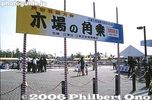
Kiba Park with Kiba Kakunori sign. Traditional folk performances are held on the same day as Koto Ward's Citizen's Festival in mid-Oct. So the park is quite crowded.
|
|
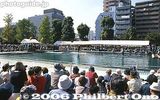
Huge crowd at Kakunori pond in Kiba Park.
|
|
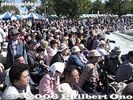
It starts at 11 am, so if you want a good view, go there early.
|
|

Kiba Sqaure Log Rolling is performed by the Kiba Kakunori Hozon-kai or Preservation Society. 木場角乗保存会
|
|

Kiba used to be where wood and lumber were stored and produced. 相乗り
|
|

Men managing the logs in the river eventually developed their own log tricks while on the job.
|
|

A long bamboo pole is used for balance.
|
|
|

Head stand
|
|
|

Double head stands
|
|

Without the bamboo pole, it is more difficult to keep your balance.
|
|

Splash!
|
|

He tries again and succeeds in unfurling a banner which says "Koto Ward, Water Capital."
|
|

Woman roller.
|
|

Log rolling lessons are given at a local pool. Lot of children are good at it. I tried it once too. Very difficult...
|
|

The middle of the foot must land on the corner to turn the log.
|
|
|

Rolling with a fan. 扇子乗り
|
|

Rolling blindfolded.
|
|

Blindfolded head stand.
|
|

Rolling with geta clogs. 駒下駄乗り
|
|

The middle of the geta clog must land right on top of the log's corner.
|
|

Preparing for a head stand.
|
|
|
|
|

Rolling with an umbrella. 唐笠乗り
|
|

Father and son. He later turned around and rolled the other way with his son on his shoulders.
|
|

Acrobatics on a floating ladder. 梯子乗り
|
|

Ladder stunts
|
|
|
|
|
|

A real crowd pleaser.
|
|

The kanji "ki" (wood) is written on the his back on the left.
|
|

The logs are moved around with a spike-tipped bamboo pole.
|
|

One of the highlight stunts...
|
|
|

This year (2004), it was successful.
|
|

However, it is always possible that they splash down.
|
|

Another highlight and difficult stunt.
|
|
|
|
|

From the top of the blocks, he's supposed to jump onto the log in front. But he couldn't do it.
|
|

Another guy tries to do it.
|
|
|
|

He succeeds.
|
|
|

Ending chant. The performance is about 90 min.
|
|
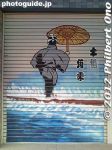
Store shutter art of Kiba kakunori in Koto, Tokyo.
|
|
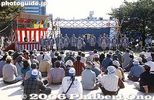
It is soon followed by the Kiba Kiyari troupe who chants Kiba workman songs.
|
|

The Kiba Kiyari songs were sung by men on the river in Kiba sorting out the logs. 木場の木遣
|
|
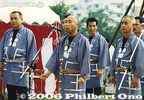
The men had to work together to move large logs on the water. They used the songs to match the rhythm of their work. The songs are said to have originated during the construction of Edo Castle by Tokugawa Ieyasu.
|
|

They also perform the Kiba Kiyari Nembutsu which is a Buddhist chant. In the old days, Kiba's logging-related workmen performed this chant whenever someone in their trade met misfortune. 木場の木遣念仏
|
|
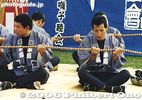
Kiba Kiyari Nembutsu. They hold and rotate a giant rosary while chanting. 木場の木遣念仏
|
|

A lion then appears.
|
|
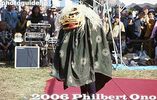
Lion dance.
|
|
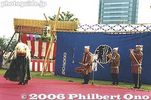
獅子舞
|
|

After this lion dance, the Fukagawa tekomai geisha performed.
|
|

Fukagawa Tekomai geisha make their entrance. 深川手古舞
|
|
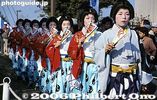
The Fukagawa Tekomai geisha make their way to the stage.
|
|

They chant without instruments.
|
|
|
|
|

Each carry a lantern bearing their name.
|
|

They always carry a flower hat, but I've never seen them wear it.
|
|
|
|
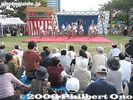
The stage in Kiba Park and spectators.
|
|
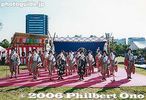
Fukagawa Tekomai Geisha performing at Kiba Park, Koto Ward, Tokyo.
|
|
|
|
|
|
|
|
|
|
|
|
|
|
|

My 2010 video of tekomai geisha performing/singing in Kiba Park.
|
|

After the tekomai geisha was the final act of the day. They were performed Fukagawa Strongman's Stunts. 深川の力持
|
|

Fukagawa Chikara-mochi
|
|

Fukagawa Chikara-mochi is traditional entertainment spawned by warehouse workers in Sagacho (near Kiba), Tokyo during the Edo Period.
|
|

They carried bags of rice, barrels of sake, etc., and tossed them in the air. It became a contest for skill and strength. Their stunts are reenacted here for this festival.
|
|

The stunts gradually get more difficult and dramatic.
|
|
|
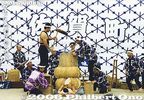
Preparing for the finale.
|
|
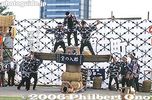
Almost 1,000 kg is on this man below. This stunts were also performed at Ueno Park for US President Ulysses S. Grant when he visited Japan in 1879 after his term ended.
|
|
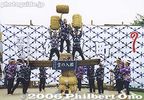
As one man lies at the bottom, everything is piled up on him. They even swayed the boat.
|
|

My 2010 video of Fukagawa Chikara-mochi in Kiba Park.
|
|
|
|